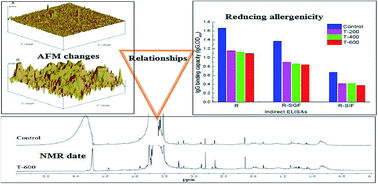AFM and NMR imaging of squid tropomyosin Tod p1 subjected to high hydrostatic pressure: evidence for relationships among topography, characteristic domain and allergenicity†
Abstract
The surface topography, characteristic domain and allergenicity of squid tropomyosin Tod p1 (TMTp1) treated under single- and two-cycle high hydrostatic pressure (HHP) were analyzed. Atomic force microscopy (AFM) showed that the HHP treatment led to the formation of a rougher surface of squid TMTp1; the two-cycle 600 MPa HHP treatment produced the largest effect, with a mean roughness, maximum height, skewness and kurtosis of 6.56 nm, 94.83 nm, 3.05 and 23.13, respectively. The HHP treatment caused lower IgE and IgG-binding capacities, indicating a significant reduction of the allergenicity (p < 0.05) due to variations in the AFM surface topography. The peaks of the main allergenic characteristics affected were 0.99, 1.16, 1.21, 1.79, 1.82, 2.84, 2.88 and 3.37 ppm (in the initial 1H nuclear magnetic resonance (NMR) spectra). The HHP treatment changed the AFM surface topography and caused the migration or disappearance of the related 1H NMR peaks; these changes were significantly correlated (p < 0.05) with the reductions in allergenicity observed.


 Please wait while we load your content...
Please wait while we load your content...